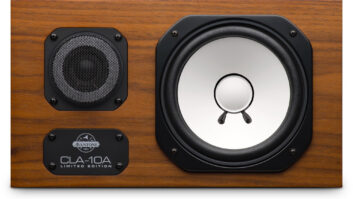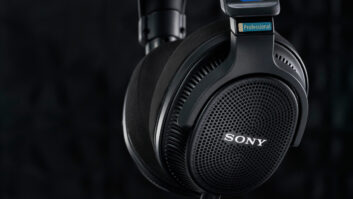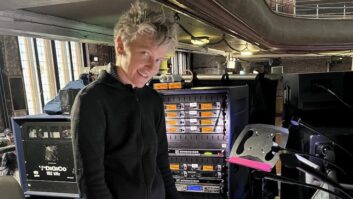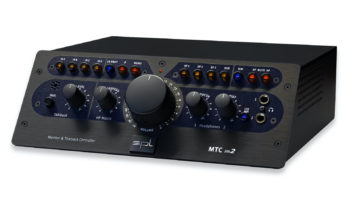Monitor engineer Mark Hughes, Lenny Kravitz (2002):
Onstage, monitor engineer Mark Hughes uses a Midas XL4 with an XL3 extender; like Natale, Hughes prefers to keep the signal flow short and easy to control, without the aid of a computer. “I prefer active mixing; it’s fun because it is precise,” Hughes says. For Kravitz’s vocal, Hughes uses an API mic pre and a Lucas tube compressor/tube EQ. Kravitz and band all wear Future Sonics in-ear monitors (IEMs) driven by either Shure PSM600 or Sennheiser 300 transmitters. To keep Kravitz’s in-ear mix consistent with Natale’s FOH mix, Hughes takes an effects submix from the FOH PM4000 and adds that mix into Kravitz’s IEMs after heavy protection limiting through a BSS DPR-404 4-channel compressor. Hughes also runs a set of sidefills to add low end to the stage.
“The in-ears are really good for the stage sound,” comments Natale. “As loud as Lenny plays, if he had to rely on wedge monitors up there, he wouldn’t sound nearly as good out front with all of the extra bleed going on.”
Mix sound reinforcement editor on using the Yamaha PM5D to organize wedges and in-ears:
Sticking with the familiar system of numbering monitor mixes — going from stage right to left and from downstage to up — will keep you from having to repatch when you get on someone else’s system for a festival or support act. Organizing the way wedges, in-ears and effects send is a matter of convention. The PM5D has 12 graphic EQs, so assign them to the first dozen auxes for use as wedge mixes.
Using the first four of the eight internal effects with the last four auxes also makes sense. These first four effects are normally returned to the four stereo effects returns, leaving auxes 13 to 20 for use as four stereo-linked in-ear mixes. The four stereo effects returns don’t have gates or compressors, but the four stereo line returns do, and those on the PM5D-RH versions have mic preamps and could be used for ambience mics.
Monitor engineer Ian Beveridge, Foo Fighters (2003):
Beveridge explains the in-ear mix for Hawkins and Mendel in this way: “Nate has a single three-way box there that is just for backup in case anything happens; he also has an in-ear stereo mix, and Taylor has an in-ear stereo mix, as well. We use Shure 700 Series transmitters and receivers. On the drum stool, there are two Tactile Audio Thumpers and a ButtKicker 2.”
Grohl and Shiflett have a variety of wedges, some for music and some for vocals. “We use a Rat three-way wedge that is really great for music. I don’t think it does vocals well, though, so we have a music mono system for Dave with two 2×15s with a 10-inch and a 2-inch in them. For Chris, I have one 2×15 with 10-inch and a 2-inch. On the outsides, for vocals, both Dave and Chris have two two-way wedges 1×15s with TAD 2-inch drivers with a Radian diaphragm, which I think sounds a lot better than the TAD diaphragm for the vocals. The sidefills are Rat Trap boxes, one high pack and two subs per side; the subs are the 18-inch P.A. subs. All of the crossovers are BSS.”
As for his approach to mixing monitors, Beveridge explains, “Taylor has an FOH stereo mix in his in-ears, with toms panned from left to right. Everything is compressed and gated like it is at FOH. Dave’s guitar is fairly central, while Chris is panned as Taylor sees it onstage: to stage right. Because he is next to Nate onstage, he only gets a little bass. There are two reverbs, a snare and hall reverb, and a gated reverb. It’s an intense-sounding mix. You could record it and it would sound pretty respectable. Nate’s mix is almost the same, except the guitars are panned hard left and hard right so that the bass appears in the middle of the guitars. There is a lot more bass in there. It makes it easy at festivals because you call up the same mix and change the pan. The really good thing about the Yamaha board is that for in-ears, you need a lot of EQ, and the Yamaha has tons of power for EQ. You can do whatever EQ you need, and since it is digital, there are no phase problems.”
Because Mendel and Hawkins use both in-ears and wedges, Beveridge uses multiple feeds. “There are two kick drum feeds from different mics, and rather than blending the two, I use one for the in-ears and the other for the wedges, and I can EQ them differently as needed. That goes for the guitars, as well; I use one feed for the in-ear mix and one for the wedge mix. It’s pretty consistent; normally, I set compressors above inputs so that if anything changes, it hits the compressor a little harder. If the guitar techs are turning it up, I can tell and it stops things from changing in my guys’ ears. Dave gets a full-band mix in his three-way wedges. His vocal is split to two channels: one compressed and one uncompressed. The compressed one is compressed hard for the in-ear mixes and the sidefills so Chris doesn’t get deafened by Dave’s vocals. The uncompressed mix goes to the two-way wedge. Chris’ mix is almost the same. Chris only has one music wedge because he has the sidefills near him. I can EQ the guitar and take a lot of the high end out for the wedge mix. Chris also has some bass and guitar and lots of drums. The sidefills are basically drums, Dave’s guitar and Dave’s voice. Chris’ sidefill is a bit louder since his guitar is so loud; he gets his guitar from the cabinets behind him and the wedge in front of him, and he can take cues off of Dave’s guitar from what he hears in the sidefills.”
Monitor engineer Shaun Sebastian, Black Eyed Peas, N.E.R.D. (2004):
The main difference between the two bands, Sebastian explains, is that the Black Eyed Peas still use wedges. “Four of the eight members are on in-ears; the others use the wedges,” he says. “So it’s not as clean of a mix. The N.E.R.D. guys are all on in-ears, so it’s much easier and much cleaner-sounding.” Both bands are using Ultimate Ears UE-10s, while the wedges are all house models.
According to Haines, each of the four front wedges get the same mix. “The four vocalists are such a whirlwind up there, it’s silly to divide them out. They’re running everywhere and they’re not even in front of the wedges half of the show.”
Both bands are fairly low maintenance for Sebastian. “Now that I have the D5 out here, I don’t really do much,” he admits with a laugh. “I really shouldn’t be saying that, but everything is programmed now. There might be a move here or a move there, but for the most part, it’s all consistent.” For Black Eyed Peas, he’ll move guitarist Pajon’s wedges up during a solo, and at various times, he’ll boost vocalist Fergie’s in-ears.
Monitor engineer Paul Owen and front-of-house engineer Big Mick, Metallica (2003):
It was only four years ago, during the orchestra dates with the San Francisco Symphony, that the band first wore in-ears. Owen relates that it was evident that the band truly heard themselves when they went on ears, especially Ulrich. “Lars had always worn thick ear plugs and listened to a huge drum monitor. So a lot of the notes they had never heard. So if James questions him, ‘You’re playing the end of “Master [of Puppets]” wrong,’ Lars is like, ‘I’ve always played it that way.’ It’s just because he’s heard it now!”
But the switch to UE5 ears wasn’t easy and isn’t across the board: Hetfield didn’t like the isolation of it (he has 12 dB of ambience in his ears), so Owen still uses a full monitor system because the band plays off of his guitar. “They can’t work in complete isolation,” Owen explains. “James wants to hear exactly his instrument and where he goes, so you have to follow James’ vocal and send it to him. Except you can’t have 15 vocals wide open in his ears, and you can’t really gate them down: Some guys sing soft, and some guys sing hard. So it’s a constant following around. Lars only hears certain parts of James’ vocal and certain parts taken out. Same with Kirk [Hammett, guitarist]: He wants to be followed entirely around the 200-foot stage with 24 mixes. Same with Rob [Trujillo, bassist]. Rob had never worn in-ears until he came to Metallica. And he’s just on one ear [his left], which is a heavy bass driver. And the rest all follow him around on the wedges onstage, which is similar to what Jason [Newsted, former bassist] was. Bassists are pretty hard to convince to stay on in-ears. They do generate a lot of low end.”
The transition to in-ears is a fine example of Metallica’s ever-changing sound. In fact, as Big Mick explains, creating that distinctive Metallica sound has been all about “cause and effect”: “There’s a problem; it causes me to think about it, and then I effect a change to try and fix the problem.
“So, basically,” Big Mick concludes, “all we’ve done over the years is learn how to refine each of the individual sounds to make a cumulative big sound with the topic of music at hand. I don’t use any samples at all; the kick drums, snare drums, tom toms, everything is real. I think more engineers need to do more experimenting and thinking about what they’re trying to achieve. I just think it is very easy to follow what everybody has always done. If it doesn’t work, you have to adopt a plan. I don’t mind telling people my plans. It’s not a competition; I’m just doing a job. If I come up with a good idea and if everybody can benefit from it, then why not? It doesn’t matter. We’re all trying to earn a living.”
Monitor engineer Glen Collett, Mariah Carey (2000):
Only Carey and her four backup singers use wireless mics, with two additional wireless ready for various guest artists such as Missy Elliott and Da Brat, who sometimes drop in for the show.
There’s plenty of other RF flying around the stage, however; although Carey herself relies on traditional monitor wedges, the rest of the band use Ultimate Ear UE5 two-way monitors, three of them wireless.
“I try and keep it to a minimum,” notes monitor mixer Collett, a Nashville resident whose credits include Bette Midler, Julio Iglesias and 16 years with Bryan Adams. “The people that are stationary I try to keep wired in order to keep the total number of radio frequencies onstage down as much as possible. On this tour, only the bass player and two of the singers are wireless.
“Reception problems are always of paramount concern. The airwaves are getting more and more jammed, and, once you put a pair of little monitors inside your ears, any kind of bad reception is a real problem. Essentially, you have a little stereo FM radio station on your belt. It just happens to be turned to a frequency that, hopefully, isn’t being broadcast by TV, or radio or anybody else.”







